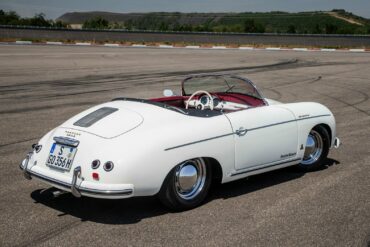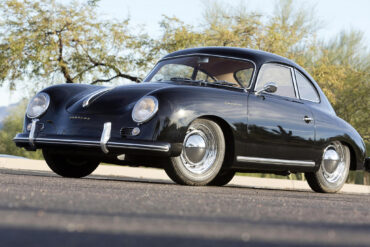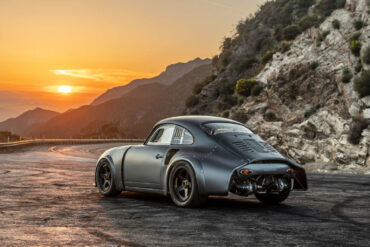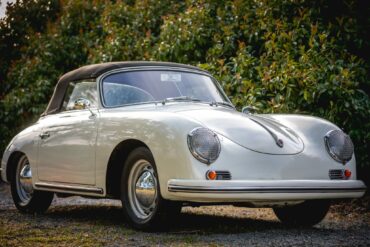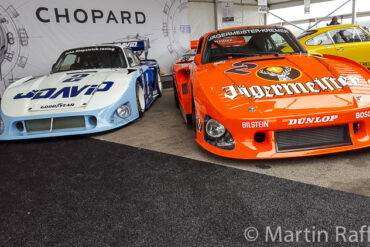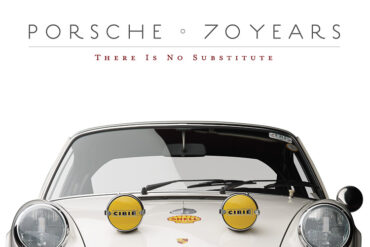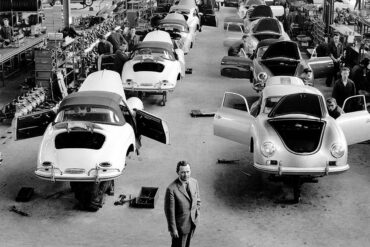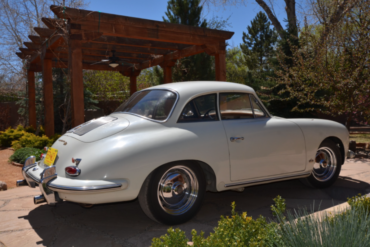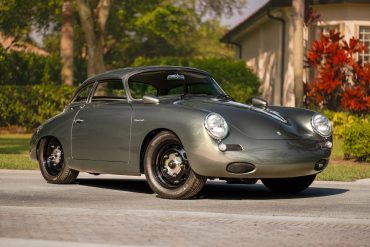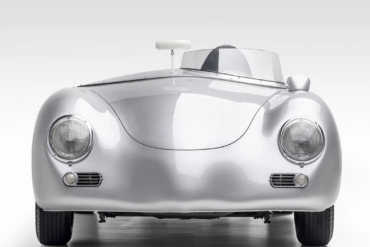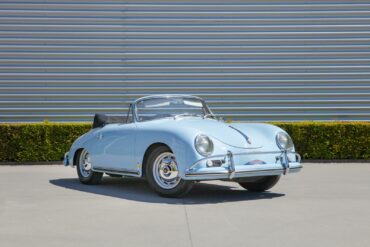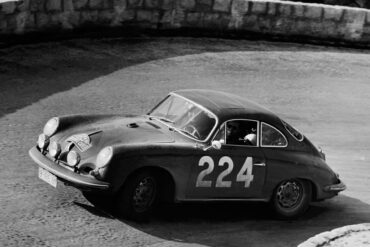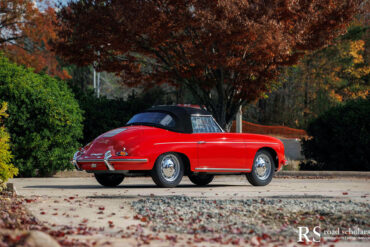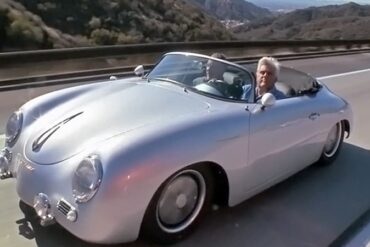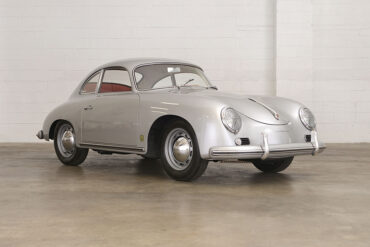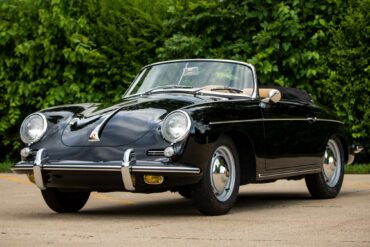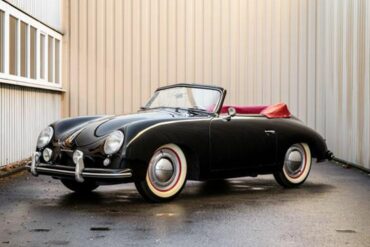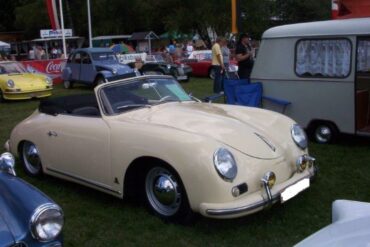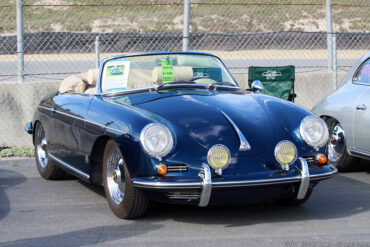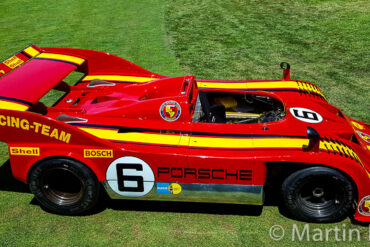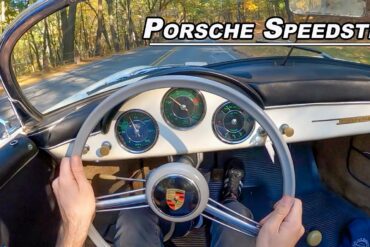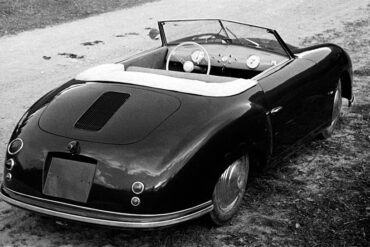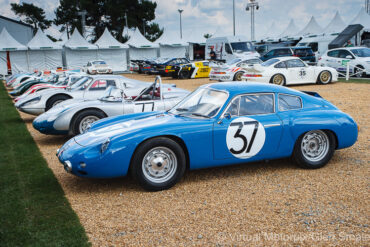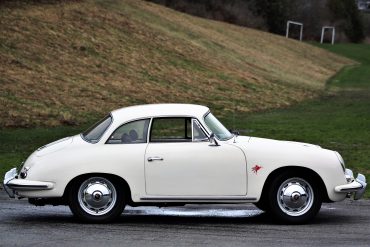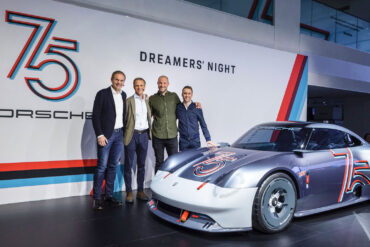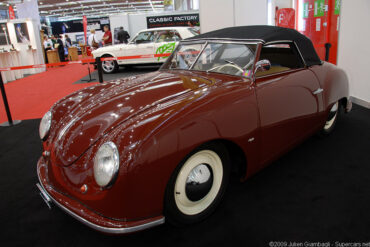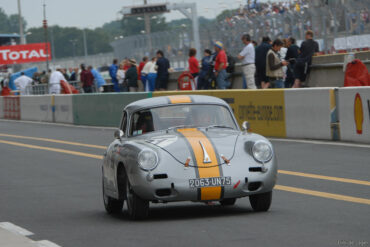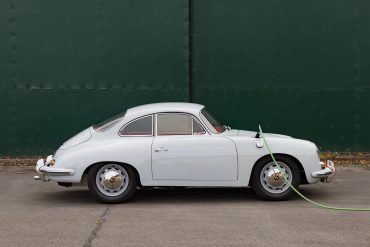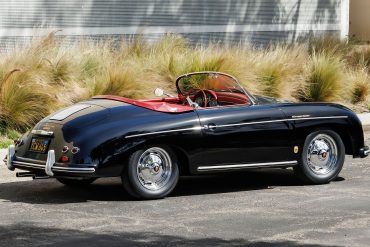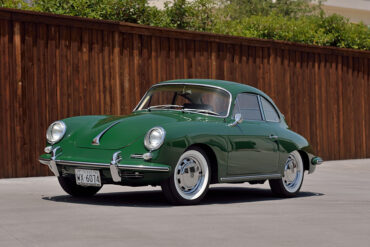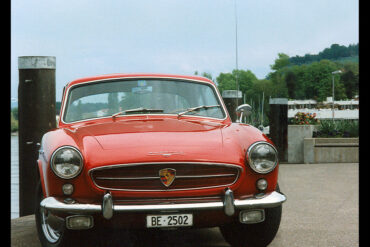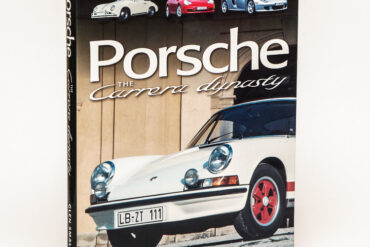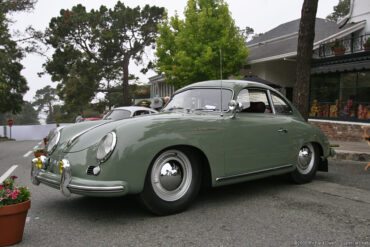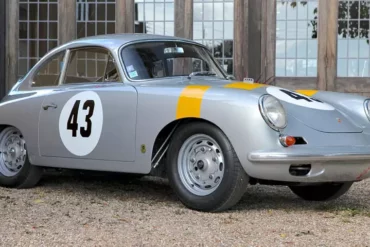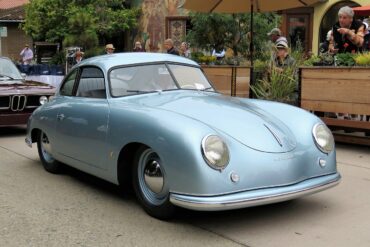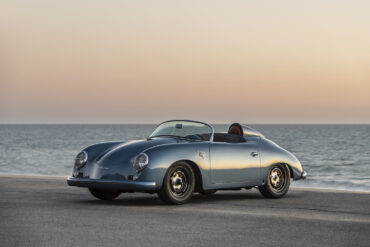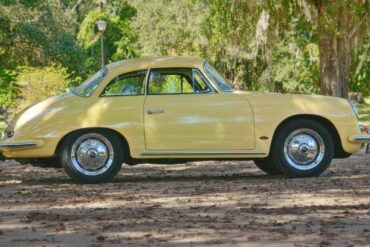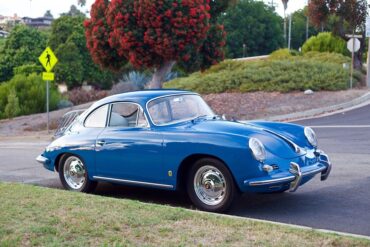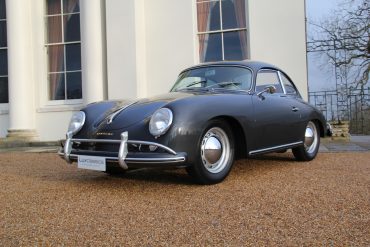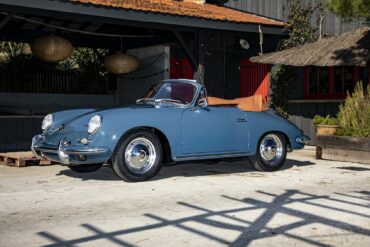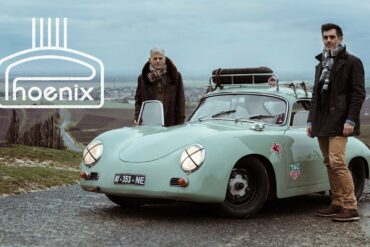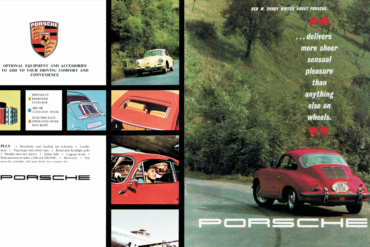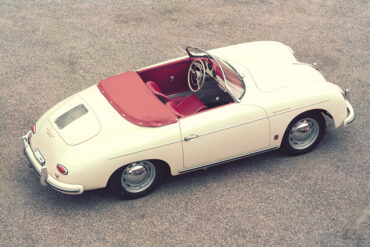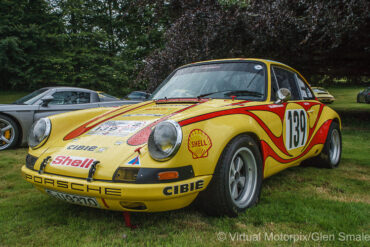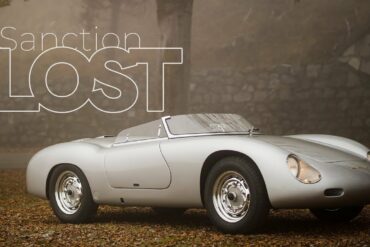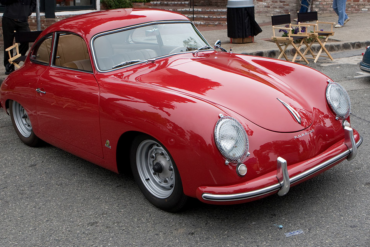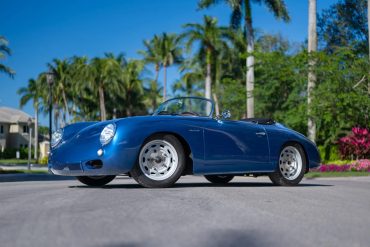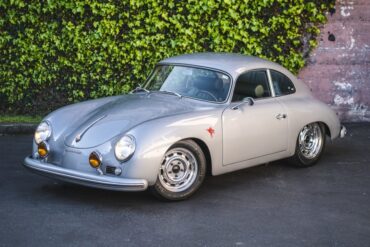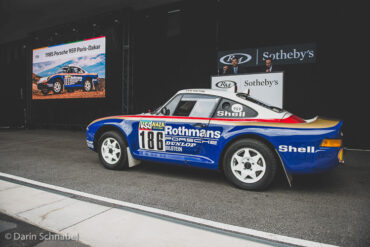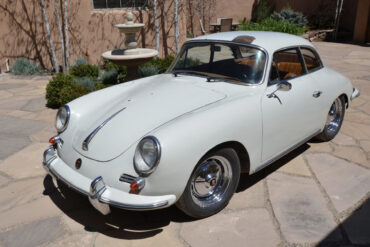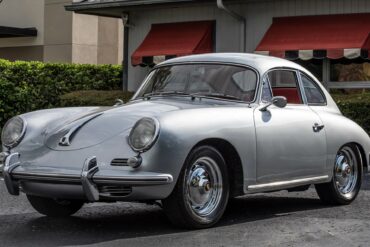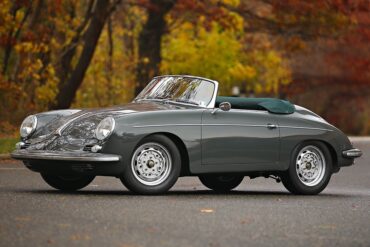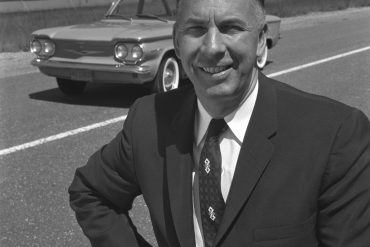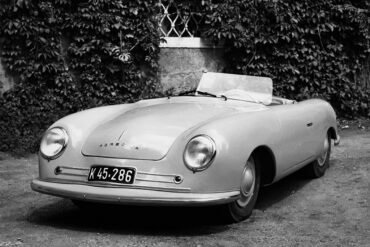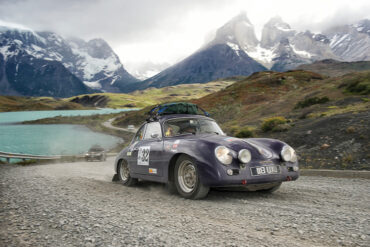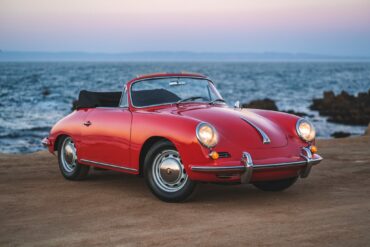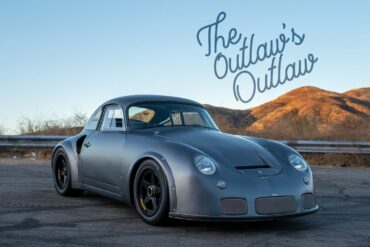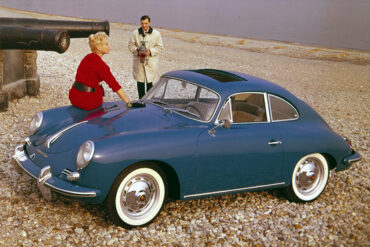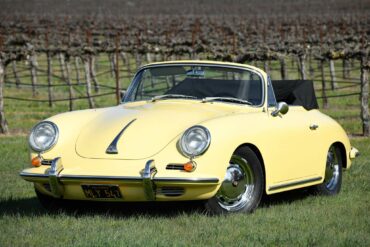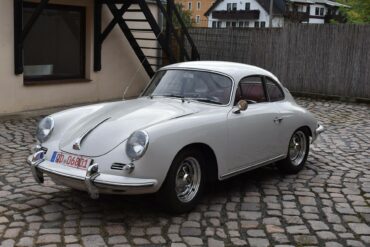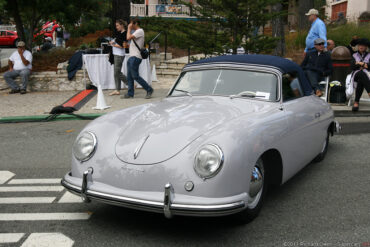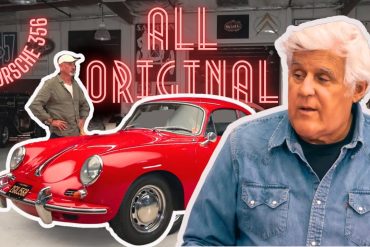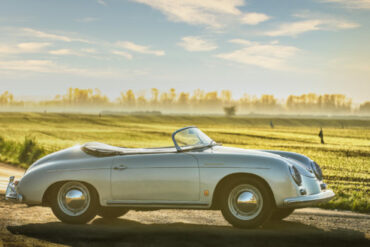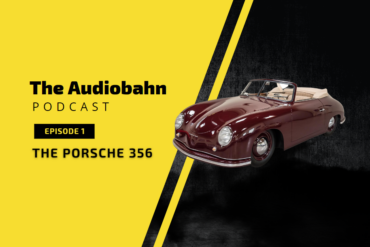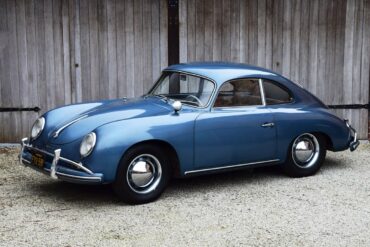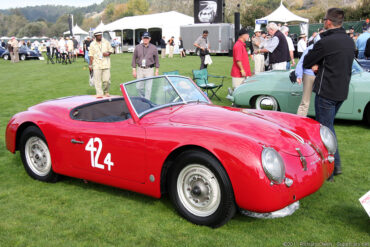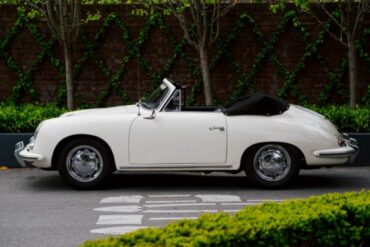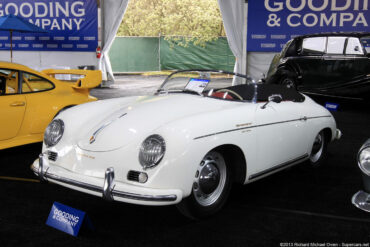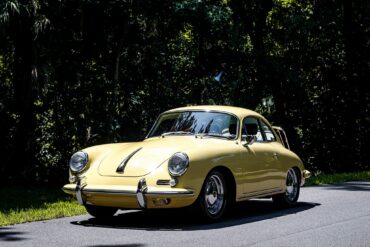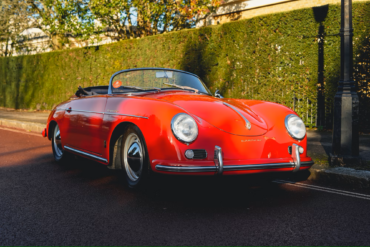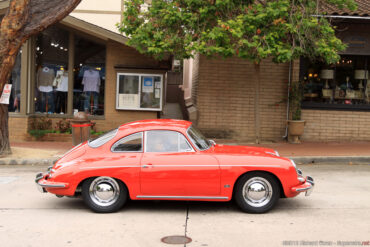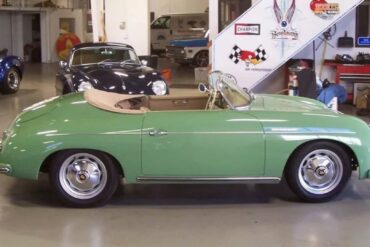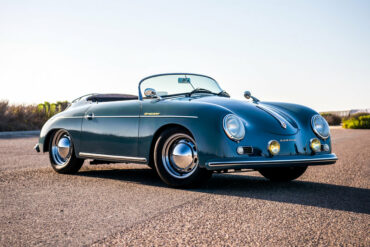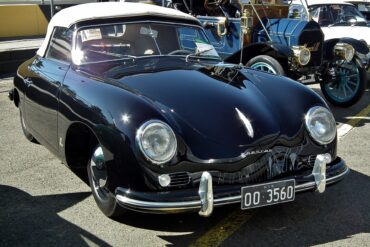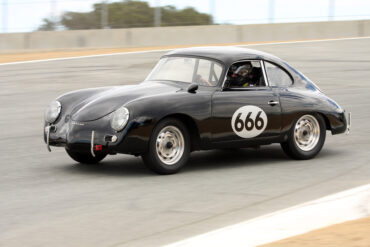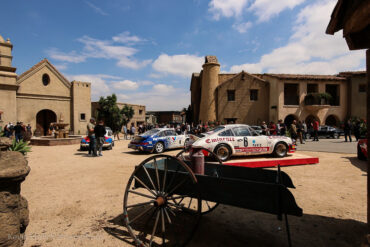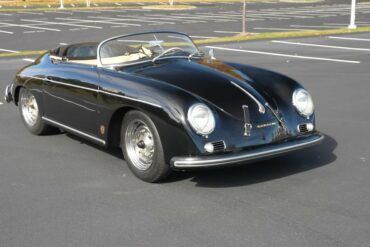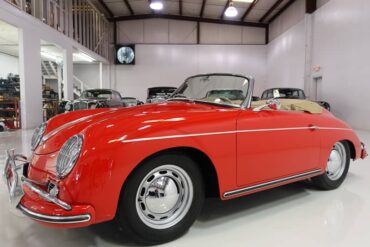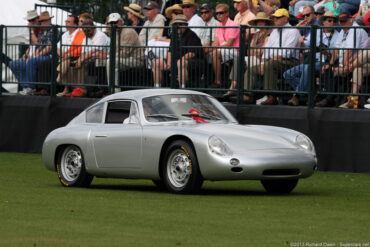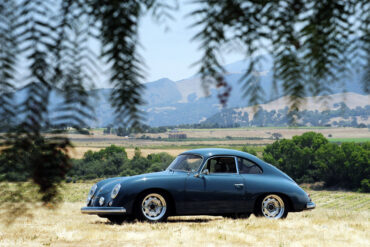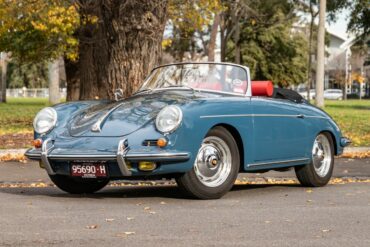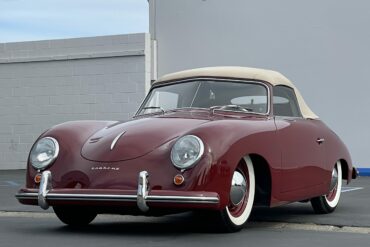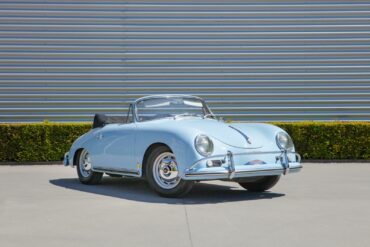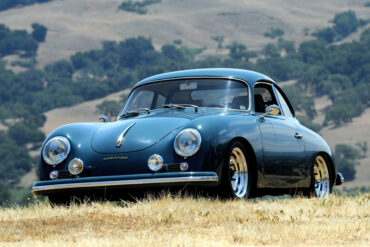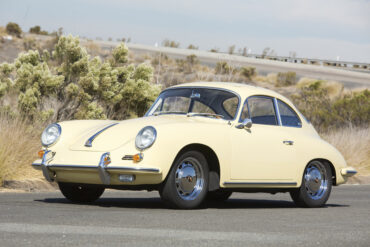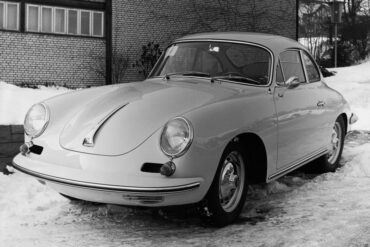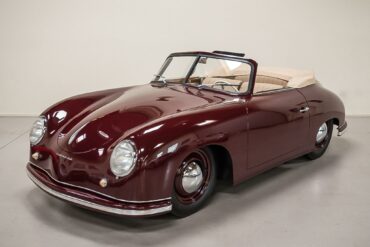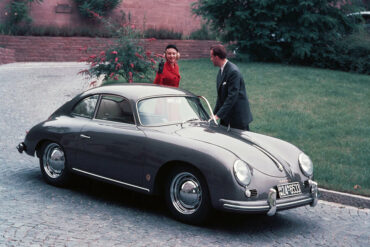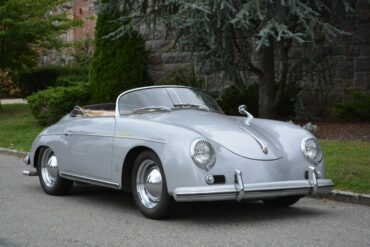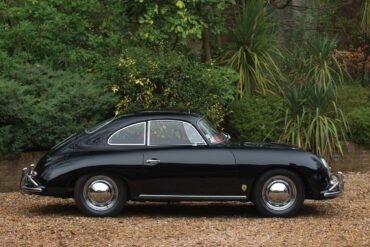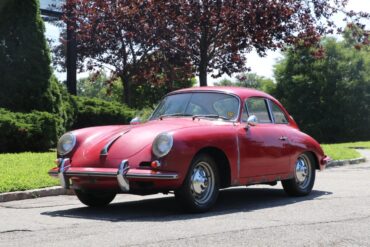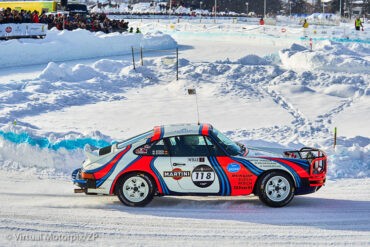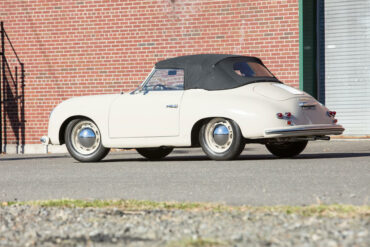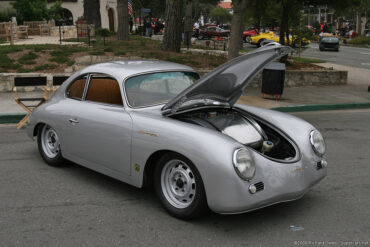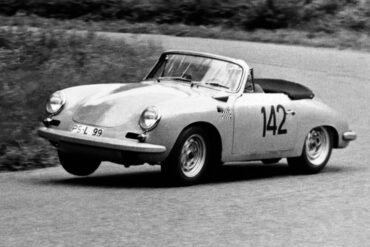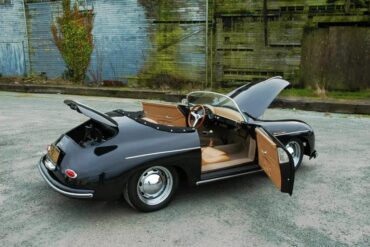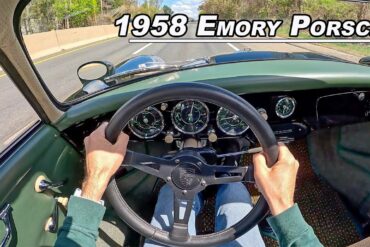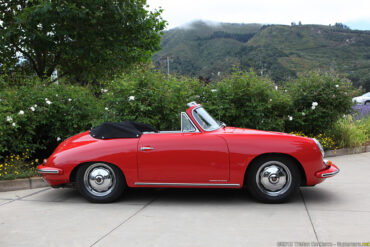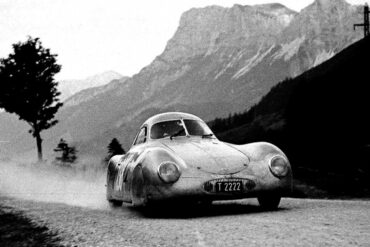1954 – 1955 Porsche 356/1500 Speedster Technical Specifications Type Series Production Car Built At Stuttgart, Germany Body Stylist Erwin Komenda...
The Porsche 356 was the first production car from Porsche. Earlier cars designed by the company included Cisitalia Grand Prix...
Want to Join the Outlaw Gang? Rod Emory makes some of the most insane modified Porsches out there. This Porsche...
1956 – 1957 Porsche 356A/1300 Super Cabriolet Pictures & Gallery...
Rennsport Reunion poster collection, from Rennsport I through VI It’s hard to know where to begin when writing a report...
Porsche 70 Years – There Is No Substitute: by Randy Leffingwell © Quarto Publishing It’s a heavyweight book, landscape in...
The world of early Porsche production This footage was taken between late 1959 and late 1961. Great view into the...
1961 – 1963 Porsche 356B/1600 S Notchback Coupe Technical Specifications Type Series Production Car Production Years 1959 – 1963 Built...
The Porsche 356 quickly found a new home in Southern California among hot rod enthusiasts, after landing in American shores....
It’s really hard not to love this Porsche 356 A Carrera Speedster! Photo Credit: Ted7 (@iamted7)...
1956 – 1957 Porsche 356A/1300 Cabriolet Technical Specifications WHAT BODY STYLE? 2 door fixed-head coupé with 2+2 seats HOW LONG?...
Amongst Porsche 356 enthusiasts, perhaps no model is more coveted than a C-Series Carrera 2. The Carrera 2 represents the culmination of Porsche’s racing technology fitted into a road car package and the ultimate performance-first sports car in the 356 model lineup. The 1,966-cubic centimeter, mechanically complex four-cam Type 587/1 engine was the most powerful unit that Porsche had ever created for a production car, developing 130 brake horsepower at 6,200 rpm.
Reviewed and Edited by Rex McAfee Impeccable numbers matching 356B S90 Roadster In 1959, Porsche introduced a complete update of...
1957 Porsche 356A Outlaw Chuck Olenyk turned this coulda-been shoulda-been coupe into a classic speedster with all factory parts –...
1956 – 1959 Porsche 356A/1600 Coupe Technical Specifications Production Years 1956 – 1958 Released At 1955 Frankfurt Motor Show Built...
1959 – 1963 Porsche 356B/1600 S Roadster Pictures & Gallery...
1953 – 1955 Porsche 356/1500 Super Cabriolet (Pre-A) Technical Specifications Type Series Production Car Production Years 1953 – 1955 Built...
1952 – 1954 Porsche 356/1100 Cabriolet (Pre-A) Pictures & Gallery...
1959 – 1963 Porsche 356B/1600 Roadster Gallery Porsche 356 B 1600 Roadster (T5) – Pictures & Gallery Porsche 356 B...
Plenty of 911-based cars were entered in the Concours The Hillsborough (California) Concours d’ Elegance, on 21 July 2019, has...
POV Drive In 356A Speedster This 1956 Porsche 356A Speedster is completely original and unrestored making it incredibly rare. It...
Porsche 356/2 Gmünd Cabriolet Pictures Of the 50 cars made in Gmünd, only eight were built up as cabriolets. Each...
Porsche 356 Carrera GTL Abarth on 05/07/2018 at the Le Mans Classic, 2018 Although the temperatures have hovered around the...
1959 – 1963 Porsche 356B/1600 S Notchback Coupe Pictures & Gallery...
Celebrating the birth of a legendary brand In 1948, Ferry Porsche realized his dream of a sports car: with his...
Porsche 356/2 Gmünd Cabriolet Specifications type Series Production Car production years 1948 – 1951 built at Austria production 41 price...
1959 – 1963 Porsche 356B/1600 Coupe Pictures & Gallery...
Electrogenic, a UK firm is responsible for the conversion of this classic 1963 Porsche 356 into a full-blown EV. The...
While the staff here at Stuttcars can never get enough of Porsche’s latest GT3s and 963 prototypes, there’s true reverence...
Porsche 356 Paint Color Options This post outlines all the color options for the 356 over its production life. We...
Ferry Porsche had in fact requested Swiss technicians to make a less sporty and more elegant version of the 365 B and thus the 1600 Beutler Coupè was born. This project is a 2+2 based on a Porsche 1600. Like the Porsche, the car is built on a VW platform, but includes Porsche elements such as the brakes and the engine. It was built in 5 copies before production was stopped in 1957 due to a change in commercial strategies by the German company.
Porsche: The Carrera Dynasty by Glen Smale © Glen Smale A Spanish noun, ‘carrera’ can mean road, track or race...
1955 Porsche 356/1500 Continental Coupe (Pre-A) Technical Specifications Type Series Production Car Built At Stuttgart, Germany Body Stylist Erwin Komenda...
Around 20 Super 90 Coupes were ordered with the lightweight GT package for racing. They used aluminum panels, a lightweight interior and plexiglas windows to shed over 200 lbs off the standard production coupe. Inside the car came equipped with a roll bar, leather-strap window lifts and speedster seats. Aluminum exterior panels included the doors, hood, rear deck lid.
1951 – 1953 Porsche 356/1300 Split-Window Coupe (Pre-A) Pictures & Gallery...
Shifting the Recipe a Bit Rod Emory of Emory Motorsports has revealed the 1959½ Speedster. It’s the latest evolution of...
1959 – 1963 Porsche 356B/1600 Notchback Coupe Pictures & Gallery...
1959 – 1963 Porsche 356B/1600 S Coupe Technical Specifications Type Series Production Car Production Years 1959 – 1963 Built At...
A Beautiful Piece of Porsche History The 1960 Porsche 356B Roadster is an automotive icon. The vehicle is one of...
From the outside, the 356A kept to the Porsche mantra of stepwise evolution. The new model was outwardly identical to the previous version except for the wider tires, a small rub-strip below the doors, a fully-curved front window and enamel paint replacing lacquer previously used. The 356 A came with an all-alloy air-cooled Flat 4 engine in four states of tune, with the 1300 having Type 589/2 engine with 60 bhp and 65 lb-ft of torque.
1961 – 1963 Porsche 356B/1600 Super 90 Cabriolet Technical Specifications Type Series Production Car Production Years 1959 – 1963 Built...
The Auratium Green 356 A Type 2 Please turn on Closed Captions to enjoy this film in English. This is...
Porsche 356 Sales Brochures Clearly going back this far, sales catalogs for Porsche cars are hard to find. When it...
1956 – 1958 Porsche 356A/1600 Speedster Technical Specifications Production Years 1956 – 1958 Released At 1955 Frankfurt Motor Show Built...
Rennsport Collective, Donington Hall, 20 July 2019: Porsche 996 GT1 Evo 1997 on display with numerous other Porsche classics They...
Porsche 356 Carrera Speedster Zagato Please turn on closed captions to enjoy this film in English. Zagato is turning 100 years...
1953 – 1955 Porsche 356/1500 Super Coupe (Pre-A) Technical Specifications Type Series Production Car Production Years 1953 – 1955 Built...
Emory Motorsports stands as the global benchmark for creating bespoke Porsche 356 vehicles, melding the essence of the Porsche brand...
From the outside, the 356A kept to the Porsche mantra of stepwise evolution. The new model was outwardly identical to the previous version except for the wider tires, a small rub-strip below the doors, a fully-curved front window and enamel paint replacing lacquer previously used. The 356 A came with an all-alloy air-cooled Flat 4 engine in four states of tune, with the 1300 having Type 506/2 engine with 44 bhp and 60 lb-ft.
1985 Porsche 959 Paris-Dakar – chassis #WP0ZZZ93ZFS010015 (courtesy of RM Sotheby’s) Lot #196, the 1985 Porsche 959 Paris-Dakar, outstripped its...
1961 – 1963 Porsche 356B/1600 Super 90 Notchback Coupe Pictures & Gallery...
PCarMarket is currently offering a 1960 Porsche 356B Sunroof Coupe that has been restored by its previous owner before it...
1959 – 1963 Porsche 356B/1600 Roadster Technical Specifications Type Series Production Car Production Years 1959 – 1963 Built At Stuttgart,...
People usually recall the Chevrolet Corvair as the car that was “unsafe at any speed” which is rather unfair because...
Porsche 356/1 Pictures Today we call the first mid-engined Porsche roadster as 356/1 (or 356 no. 1) to distinguish it...
Molly ready for the Peking to Paris rally in 2007 © David & Julie Harrison She was manufactured in 1958,...
1964 – 1965 Porsche 356 SC Cabriolet Pictures & Gallery ...
They call it the 356 RSR Rod Emory’s parents brought him home from the hospital in a hot-rodded short wheelbase...
The 356 B T5 Coupe was the direct replacement of the Porsche 356 A Coupe. The T5 Coupe bodies were produced by German coachbuilder company Reutter. The 356 B T5 Coupe played a huge role in the growth seen by Porsche in the early 1960s. Like the Cabriolet, Roadster, and Notchback Coupe siblings, the Coupe was offered with 1600, 1600S, S90, and Carrera engine options paired to a four-speed synchromesh 741 transmission. In late 1961, Porsche introduced the T6 body and updates, which built on the success of its very popular predecessor.
1964 – 1965 Porsche 356 SC Cabriolet Technical Specifications Model Years 1964 – 1965 Built At Stuttgart, Germany Engine Flat-4...
1959 – 1963 Porsche 356B/1600 Super 90 Coupe Pictures & Gallery ...
1952 – 1955 Porsche 356/1500 Cabriolet (Pre-A) Pictures & Gallery...
Porsche is most renowned for the 911, but it was the 356 that first established the German brand’s reputation. In...
A True Porsche Specimen The Porsche 356A Speedster is a beautiful car and an important part of Porsche’s long motoring...
Episode One: The Porsche 356 Summary Welcome to The Audiobahn, the Stuttcars.com podcast focused on all things Porsche. In our first...
1956 – 1957 Porsche 356A/1300 Super Coupe Technical Specifications WHAT BODY STYLE? 2 door fixed-head coupé with 2+2 seats HOW...
1952 Porsche 356 ‘America Roadster’ Pictures & Gallery...
1964 – 1965 Porsche 356 C 1600C Cabriolet Technical Specifications Model Years 1964 – 1965 Built At Stuttgart, Germany Engine...
1956 – 1958 Porsche 356A/1500GS Carrera Speedster Pictures & Gallery...
1964 – 1965 Porsche 356 SC Coupe Technical Specifications Model Years 1964 – 1965 Built At Stuttgart, Germany Engine Flat-4...
Collecting Cars is currently offering a 1957 Porsche 356 A Speedster that was purchased and owned for 50 years by...
1964 Porsche 356C/2000GS Carrera 2 Pictures & Gallery...
1956 – 1957 Porsche 356A/1300 Speedster Technical Specifications WHAT BODY STYLE? 2 door fixed-head coupé with 2+2 seats HOW LONG?...
1956 – 1959 Porsche 356A/1600 Super Speedster Pictures & Gallery...
In 1953, the 1300 S or "Super" was introduced, and the 1,100 cc engine was dropped. The 360 1300 Super boasts a power improvement to 60 BHP with Porsche's "Super" engine in the Porsche 356 model range. Minor visual differences were implemented such as front indicators integrated with the horn grilles and bumpers protrude from the body with over-riders. In June 1954, the plain-bearing 1300cc engine switched over to the same block as the 4cc larger roller-bearing variant.
1956 – 1959 Porsche 356A/1600 Coupe Pictures & Gallery...
Luftgekühlt 6 – Porsche 356 street scene There was an obvious irony to Luftgekühlt 6. Somehow an event devoted to...
Join Tedward as he gives the features of the 1957 Porsche 356 Speedster, and take out this very beautiful car...
1959 Porsche 356A/1600 Super Speedster Technical Specifications Model Year 1956 – 1958 Built At Stuttgart, Germany Body Stylist Erwin Komenda...
1960 – 1961 Porsche Abarth 356B Carrera GTL Pictures & Gallery...
1954 – 1955 Porsche 356/1300 Super Coupe (Pre-A) Pictures & Gallery...
1959 – 1963 Porsche 356B/1600 Super 90 Roadster Pictures & Gallery...
1956 – 1957 Porsche 356A/1300 Cabriolet Pictures & Gallery...
1954 – 1955 Porsche 356/1300 Super Cabriolet (Pre-A) Technical Specifications Type Series Production Car Production Years 1954 – 1955 Built...
1956 – 1957 Porsche 356A/1300 Coupe Technical Specifications WHAT BODY STYLE? 2 door fixed-head coupé with 2+2 seats HOW LONG?...
1964 – 1965 Porsche 356 C 1600C Coupe Pictures & Gallery...
After a considerable absence of a Carrera model in the 356 model lineup, Porsche finally made another version with the introduction of a 2.0-liter engine. As with the earlier versions, the Carrera was offered both in a Carrera GT Deluxe version for the road and the Carrera GT for racetrack duties. Unlike these earlier models, the new car benefited from the 2.0 liter engine introduced as the Carrera 2 in September 1962.
1950 – 1951 Porsche 356/1100 Split-Window Cabriolet (Pre-A) Technical Specifications Type Series Production Car Production Years 1950 – 1951 Built...
Porsche 356 Spare Parts Catalogs (1950 – 1959 Model Year) Porsche 356/356A Parts These official Porsche PET Diagrams and codes for...
1956 – 1958 Porsche 356A/1600 Super Speedster Technical Specifications Model Year 1956 – 1958 Built At Stuttgart, Germany Body Stylist...
1956 – 1959 Porsche 356A/1600 Super Coupe Pictures & Gallery ...
1961 – 1963 Porsche 356B/1600 Super 90 Notchback Coupe Technical Specifications Type Series Production Car Production Years 1961 – 1963...
Ice Races GP, Zell am See, 19-20 January 2019: #118 Porsche 911 SC driven by Michael Stock After a 45-year...
1952 – 1954 Porsche 356/1100 Cabriolet (Pre-A) Technical Specifications Type Series Production Car Production Years 1952 – 1954 Built At...
1957 – 1958 Porsche 356A/1500GS Carrera GT Coupé Pictures & Gallery...
As with the earlier versions, the Carrera was offered both in a Carrera GT Deluxe version for the road and the Carrera GT for racetrack duties. Unlike these earlier models, the new car benefited from the 2.0 liter engine introduced as the Carrera 2 was unveiled in September 1962. The 2.0 Carrera used a variant of the Type 547 engine with a larger bore and stoke, having 1966cc.
1956 – 1957 Porsche 356A/1300 Speedster Pictures & Gallery...
Rod Emory and his team at Emory Motorsports are experts in restoring and customizing Porsche 356 coupes and convertibles. Although...
1962 – 1963 Porsche 356B/2000GS Carrera 2 Pictures & Gallery...
Story by Karl Ludvigsen Creating his own car company was “an old idea of my father’s,” Ferry Porsche recalled. The...


